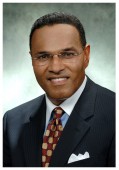
Freeman Hrabowski, III, President of UMBC
His teaching career began at age 19, when he was working on his master’s degree in mathematics at the University of Illinois (Urbana-Champaign).
Forty years later, Freeman A. Hrabowski, III is President of the University of Maryland, Baltimore County (UMBC), a position he has held for nearly two decades.
I had the pleasure of hearing Dr. Hrabowski speak yesterday at the Washington Policy Seminar of the Institute for Educational Leadership, which runs the Education Policy Fellowship Program (EPFP) of which I am part.
Hrabowski spoke with great enthusiasm and insight about many of the pressing educational issues facing our country. He brought the crowd to laughter by saying, “I get goosebumps doing math!” — but then he struck fear in our hearts by asking each of us to do a math problem. If there are 29 kids in a class, and 20 of the kids have dogs while 15 have cats, how many kids have both? (Hrabowksi said the question comes from the College Board and was originally written for sixth-graders, which of course served to raise the anxiety level of those in the audience who had no idea how to approach it.)
He was less interested in having us answer the question than in helping us remember what it feels like to be a young child or teenager who doesn’t even know where to begin a problem. He also wanted us to think about why it is that most educators love to read and believe there’s something wrong with those who don’t — but the vast majority of us don’t love math and find it perfectly acceptable if other people don’t either.
I worked out the problem while still listening to his speech and taking notes, and here’s the answer I came up with: at least six of the 29 kids. (And at most 15 — for each of those who has a cat might also have a dog.) Hrabowski wouldn’t tell us the answer, so I’m not 100 percent certain I solved it correctly.
Hrabowski also spoke of “neoteny,” which he said is a term from biology indicating the characteristic of being forever young — always asking questions, and never growing negative or cynical. The point was we all need a little more neoteny in our attitudes.
Among the other insights Hrabowski imparted to us was the fact that the U.S. doesn’t suffer from just one achievement gap. The well-known achievement gap between low-income, mostly minority children on the one hand and middle-class white children on the other hand is the domestic achievement gap; internationally, there is another achievement gap, and this one is between America’s best and the world’s best. U.S. students generally lack focus and a hunger for knowledge, Hrabowski said, and this reality is reflected in the results of international exams like the OECD‘s Programme for International Assessment (PISA) and the Trends in International Mathematics and Science Study (TIMSS).
Two final thoughts courtesy of Hrabowski: 1) “Enlightened education must involve collaboration”; and 2) “There are no more important skills than reading and thinking — and I say this as a math teacher. They’re at the core of everything we do.”
By the time Hrabowski finished answering our questions and we gave him a standing ovation, there was no doubt why Time magazine named him among the top 10 “Best College Presidents” last year.



